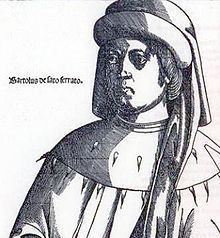Nationality Italian Occupation Law professor | Name Bartolus Saxoferrato | |
 | ||
Books Bartolus on the Conflict of Laws Education | ||
Bartolus de Saxoferrato (Italian: Bartolo da Sassoferrato) (1313 – 13 July 1357) was an Italian law professor and one of the most prominent continental jurists of Medieval Roman Law. He belonged to the school known as the commentators or postglossators. The admiration of later generations of civil lawyers is shown by the adage nemo bonus íurista nisi bartolista — no one is a good jurist unless he is a Bartolist (i.e. a follower of Bartolus).
Contents
Life and works
Bartolus was born in the village of Venatura, near Sassoferrato, in the Italian region of Marche. His father was Franciscus Severi, and his mother was of the Alfani family. He read civil law at the universities of Perugia under Cinus, and Bologna under Oldradus and Belviso, and graduated to doctor of law in 1334. In 1339 he started teaching himself first in Pisa, then in Perugia. He raised the character of Perugia's law school to a level with that of Bologna, and this city made him an honorary citizen in 1348. In 1355, Emperor Charles IV appointed him as his consiliarius. In Perugia Baldus de Ubaldis and his brothers Angelus and Petrus became pupils of Bartolus. Bartolus died in Perugia at the age of 43, and was interred in the church of San Francisco with a monument inscribed with "Ossa Bartoli".
Despite his short life, Bartolus left an extraordinary number of works. He wrote commentaries on all parts of the Corpus Juris Civilis (except Justinian's Institutes). He is also the author of a large number of treatises on specific subjects. Among these treatises is his famous book on the law relating to rivers (De fluminibus seu Tyberiadis). There are also almost 400 legal opinions (consilia) written at the request of judges or private parties seeking legal advice.
Bartolus developed many novel legal concepts, which became part of the civil law tradition. Among his most important contributions were those to the area of conflict of laws — a field of great importance in 14th century Italy, where every city-state had its own statutes and customs. Bartolus also dealt with a variety of constitutional law issues. In his treatise De insigniis et armis he discussed not only the law of Arms but also some problems of trademark law.
Bartolus also wrote on political issues, including the legitimacy of city governments, partisan divisions and the regimes of Italy's petty tyrants. His political thought balanced respect for the Empire with defense of the legitimacy of local Italian governments.
Legacy
Already famous at his lifetime, Bartolus was later regarded as the greatest jurist after the renaissance of Roman law. This is not only evident from the above-quoted saying, but also from the fact that statutes in Spain 1427/1433 and Portugal 1446 provided that his opinions should be followed where the Roman source texts and the Accursian gloss were silent. Lorenzo Valla was driven out of the university of Pavia in 1431 for his critique of Bartolus' Latin style. Even in England, where the civil law he had worked on was not applicable, Bartolus was held in high esteem. He influenced civilian writers such as Alberico Gentili and Richard Zouch.
Due to Bartolus' fame, his name was used for the character of a lawyer in many Italian plays. A well-known example is Dr. Bartolo in Pierre Beaumarchais' The Barber of Seville (play), Gioachino Rossini's opera The Barber of Seville and in Mozart's The Marriage of Figaro.
Catalogs of manuscripts
Catalogs:
